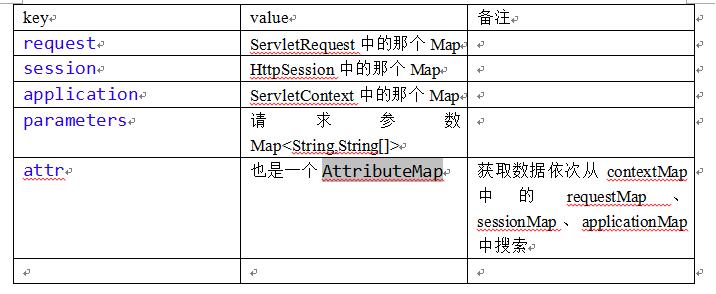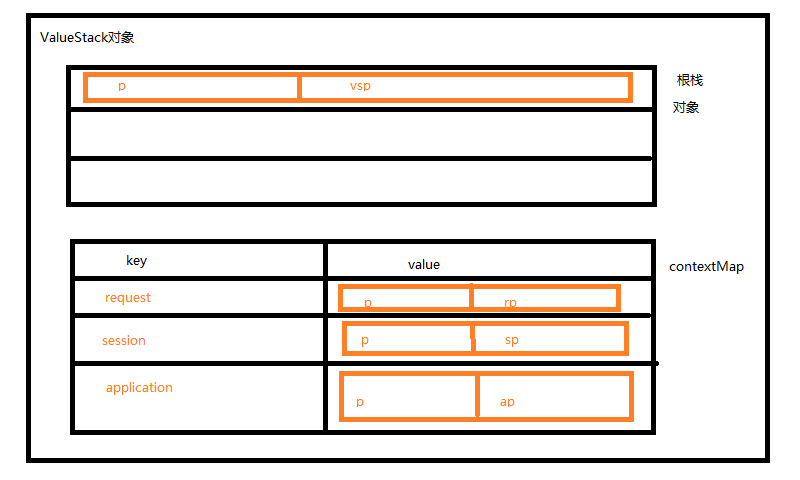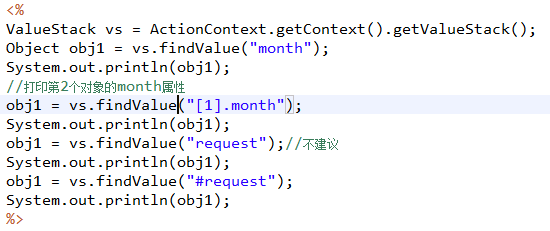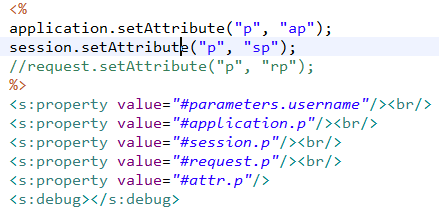contextMap中
k
5、利用OGNL获取ValueStack中:根栈和contextMap中的数据
原则:OGNL表达式如果以#开头,访问的contextMap中的数据
如果不以#开头,是访问的根栈中的对象的属性
1、在动作类中Demo1Action中重写execute方法
package com.itheima.actions;
import org.apache.struts2.ServletActionContext;
import com.opensymphony.xwork2.ActionContext;
import com.opensymphony.xwork2.ActionSupport;
import com.opensymphony.xwork2.util.ValueStack;
public class Demo1Action extends ActionSupport{
private String username = "刘小晨";
// private String p="actionP";
public String getUsername() {
return username;
}
public void setUsername(String username) {
this.username = username;
}
// public String getP() {
// return p;
// }
//
// public void setP(String p) {
// this.p = p;
// }
public String execute() throws Exception {
// ServletActionContext.getRequest().setAttribute("p", "rp");//ServletRequest中的request
ServletActionContext.getRequest().getSession().setAttribute("p", "sp");//HttpSession中的session
ServletActionContext.getServletContext().setAttribute("p", "ap");//ServletContext中的application
ValueStack vs = ActionContext.getContext().getValueStack();
System.out.println(vs);
return super.execute();
}
}
配置struts.xml
<struts>
<constant name="struts.devMode" value="true" />
<package name="p1" extends="struts-default">
<action name="showContextMap" class="com.itheima.actions.Demo1Action">
<result>/contextMap.jsp</result>
</action>
</package>
</struts>
编写contextMap.jsp页面
<%@ page language="java" import="java.util.\*" pageEncoding="UTF-8"%>
<%@ taglib uri="/struts-tags" prefix="s"%>
<!DOCTYPE HTML PUBLIC "-//W3C//DTD HTML 4.01 Transitional//EN">
<html>
<head>
<title>OGNL取contextMap中的数据</title>
</head>
<body>
<br/>取contextMap中的根中(List类型的,实际类型CompoundRoot)的数据.<br/>
<s:property value="locale"/>
<s:property value="p" /><br/><!--从栈顶开始搜索Map的key或者是对象的属性-->
<s:property value="[0]" /><br/><!--不是栈顶对象,是从索引为0处砍出来的一个新集合-->
<s:property value="[0].top" /><br/><!--栈顶对象-->
<!-- value="username"的涵义:从根中的栈顶开始,对每个对象搜索他的getUsername()方法,找到为止 -->
<br/>取contextMap中的其他的数据(非根中的).<br/>
<s:property value="#request"/><br/>
动作中的:<s:property value="p"/><br/>
请求范围:<s:property value="#request.p"/><br/>
会话范围:<s:property value="#session.p"/><br/>
应用范围:<s:property value="#application.p"/><br/>
<!-- 依次从动作\页面\请求\会话范围\应用范围查找名称为p的对象 -->
attr:<s:property value="#attr.p"/><br/>
<!-- 显示出来的东西并不是contextMap中所有的东西,只是大部分 -->
<s:debug></s:debug>
</body>
</html>
数据内存结构
6、ValueStack的常用方法
- void set(String key,Object value):先获取根栈栈顶的Map,如果不存在,压入一个新的Map
- void setValue(String ,Object):String是一个OGNL表达式。如果表达式以#开头,操作contextMap。如果不是,设置根栈中对象的某个属性,从顶到尾依次搜寻。
- Object findValue(String expr):参数是一个OGNL表达式。如果以#开头,从contextMap中找key值所对应的对象。如果不是以#开头,搜索根栈中对象的属性(getter方法)
特别注意:如果编写的表达式不是以#开头,先搜索根栈对象的所有属性,如果没有找到,会把它当做key值到contextMap中找。
- String findString(String expr):把OGNL表达式获取的对象转换成String
7、contextMap中放的常用数据
request:请求范围的数据。即ServletRequest中的那个Map
parameters:请求参数的数据。即request.getParameterMap得到
application:应用范围的数据。即ServletContext中的那个Map
session:会话范围的数据。即HttpSession中的那个Map
attr:也是一个Map。会从以下Map中依次搜索:request、session、application
五、OGNL的一些其他操作
1、投影
1、 集合的投影(只输出部分属性)
<s:iterator value="allList.{name}" var="person">
<s:property/> <br>
</s:iterator>
2、 过滤条件:this 表示集合中的元素;
a.“?#”:过滤所有符合条件的集合,如:users.{?#this.age > 19};
b.“^#”:过滤第一个符合条件的元素,如:users.{^#this.age > 19};
c.“$#”:过滤最后一个符合条件的元素,如:users.{$#this.age > 19} 。
<s:iterator value="allList.{?#this.age>25}" var="person">
<s:property value="name"/> xxxxxx <s:property value="age"/> <br>
</s:iterator>
3、 集合的投影和过滤
投影(过滤)操作返回的是一个集合,可以使用索引取得集合中指定的
元素,如:users.{?#this.age > 19}[0]
<s:iterator value="allList.{?#this.age>25}.{name}" var="person">
<s:property/><br>
</s:iterator>
<s:iterator value="allList.{?#this.age>25}[0]" var="person">
<s:property/><br>
</s:iterator>
编写TagDemo1Action
package com.itheima.actions;
import java.util.ArrayList;
import java.util.List;
import com.itheima.domain.Person;
import com.opensymphony.xwork2.ActionContext;
import com.opensymphony.xwork2.ActionSupport;
public class TagDemo1Action extends ActionSupport {
private String username="刘小晨";
private List<Person> ps = new ArrayList<Person>();
public String getUsername() {
return username;
}
public void setUsername(String username) {
this.username = username;
}
public List<Person> getPs() {
return ps;
}
public void setPs(List<Person> ps) {
this.ps = ps;
}
public String execute() throws Exception {
//初始化一些人
ps.add(new Person("安康", "女性", 7000));
ps.add(new Person("唐诗诗", "男性", 10000));
ps.add(new Person("王卫星", "有待鉴定", 10000));
ActionContext.getContext().getValueStack().setValue("#gender", "美女");
return SUCCESS;
}
}
编写jsp页面
<%@ page language="java" import="java.util.\*" pageEncoding="UTF-8"%>
<%@ taglib uri="/struts-tags" prefix="s"%>
<!DOCTYPE HTML PUBLIC "-//W3C//DTD HTML 4.01 Transitional//EN">
<html>
<head>
<title>OGNL投影等操作</title>
</head>
<body>
<br/>--------OGNL的投影查询----------<br/>
<table border="1">
<tr>
<th>姓名</th>
</tr>
<!-- ps.{nickname} ---List<String> var=“p”引用的是一个String类型的,就代表着匿名 -->
<s:iterator value="ps.{nickname}" var="p">
<tr>
<td><s:property value="#p"/></td>
</tr>
</s:iterator>
</table>
<hr/>
<br/>--------OGNL的过滤----------<br/>
<table border="1">
<tr>
<th>姓名</th>
<th>性别</th>
<th>薪水</th>
</tr>
<s:iterator value="ps.{?#this.salary>8000}" var="p">
<tr>
<td>${p.nickname}</td>
<td><s:property value="#p.gender"/></td>
<td>${p.salary}</td>
</tr>
</s:iterator>
</table>
<table border="1">
<tr>
<th>姓名</th>
<th>性别</th>
<th>薪水</th>
</tr>
<s:iterator value="ps.{^#this.salary>8000}" var="p">
<tr>
<td>${p.nickname}</td>
<td><s:property value="#p.gender"/></td>
<td>${p.salary}</td>
</tr>
</s:iterator>
</table>
<table border="1">
<tr>
<th>姓名</th>
<th>性别</th>
<th>薪水</th>
</tr>
<s:iterator value="ps.{$#this.salary>8000}" var="p">
<tr>
<td>${p.nickname}</td>
<td><s:property value="#p.gender"/></td>
<td>${p.salary}</td>
</tr>
</s:iterator>
</table>
<s:debug></s:debug>
</body>
</html>
2、创建集合对象
构造Map,如#{‘foo1’:‘bar1’, ‘foo2’:‘bar2’}。这种方式常用在给radio或select、checkbox等标签赋值上
jsp页面:
<s:radio list=“#{‘male’:‘男’,‘female’:‘女’}” name=“sex” label=“性别” />
运行结果是
<input type="radio" name="sex" id="sexmale" value="male"/>男
<input type="radio" name="sex" id="sexfemale" value="female"/>女
Action中的代码:
Map map=new HashMap();
map.put("male", "男");
map.put("female", "女");
ServletActionContext.getRequest().setAttribute("map", map);
jsp页面:
<s:property value="#request.map.male"/><br>
<s:property value="#request.map['female']"/><br>
运行结果是
男 女
<%@ page language="java" import="java.util.\*" pageEncoding="UTF-8"%>
<%@ taglib uri="/struts-tags" prefix="s"%>
<!DOCTYPE HTML PUBLIC "-//W3C//DTD HTML 4.01 Transitional//EN">
<html>
<head>
<title>利用OGNL创建List和Map(很重要)</title>
<s:head/>
</head>
<body>
<!--
规律:
通用标签:
value属性:大部分都是OGNL表达式(90%)
UI标签:表单有关
value属性:大部分都不是OGNL表达式(90%)
如果要当做OGNL表达式对待:使用%{}
如果要把OGNL当做字符串对待:使用''
-->
<br/>-----创建List-------<br/>
<s:iterator value="{'a','b','c'}" var="s">
<s:property/><br/>
</s:iterator>
<br/>-----创建Map----有点像Json---<br/>
<s:iterator value="#{'a':'aaa','b':'bbb','c':'ccc'}" var="me">
### React
* 介绍一下react
* React单项数据流
* react生命周期函数和react组件的生命周期
* react和Vue的原理,区别,亮点,作用
* reactJs的组件交流
* 有了解过react的虚拟DOM吗,虚拟DOM是怎么对比的呢
* 项目里用到了react,为什么要选择react,react有哪些好处
* 怎么获取真正的dom
* 选择react的原因
* react的生命周期函数
* setState之后的流程
* react高阶组件知道吗?
* React的jsx,函数式编程
* react的组件是通过什么去判断是否刷新的
* 如何配置React-Router
* 路由的动态加载模块
* Redux中间件是什么东西,接受几个参数
* redux请求中间件如何处理并发
**[开源分享:【大厂前端面试题解析+核心总结学习笔记+真实项目实战+最新讲解视频】](https://bbs.csdn.net/topics/618166371)**































 667
667

 被折叠的 条评论
为什么被折叠?
被折叠的 条评论
为什么被折叠?








